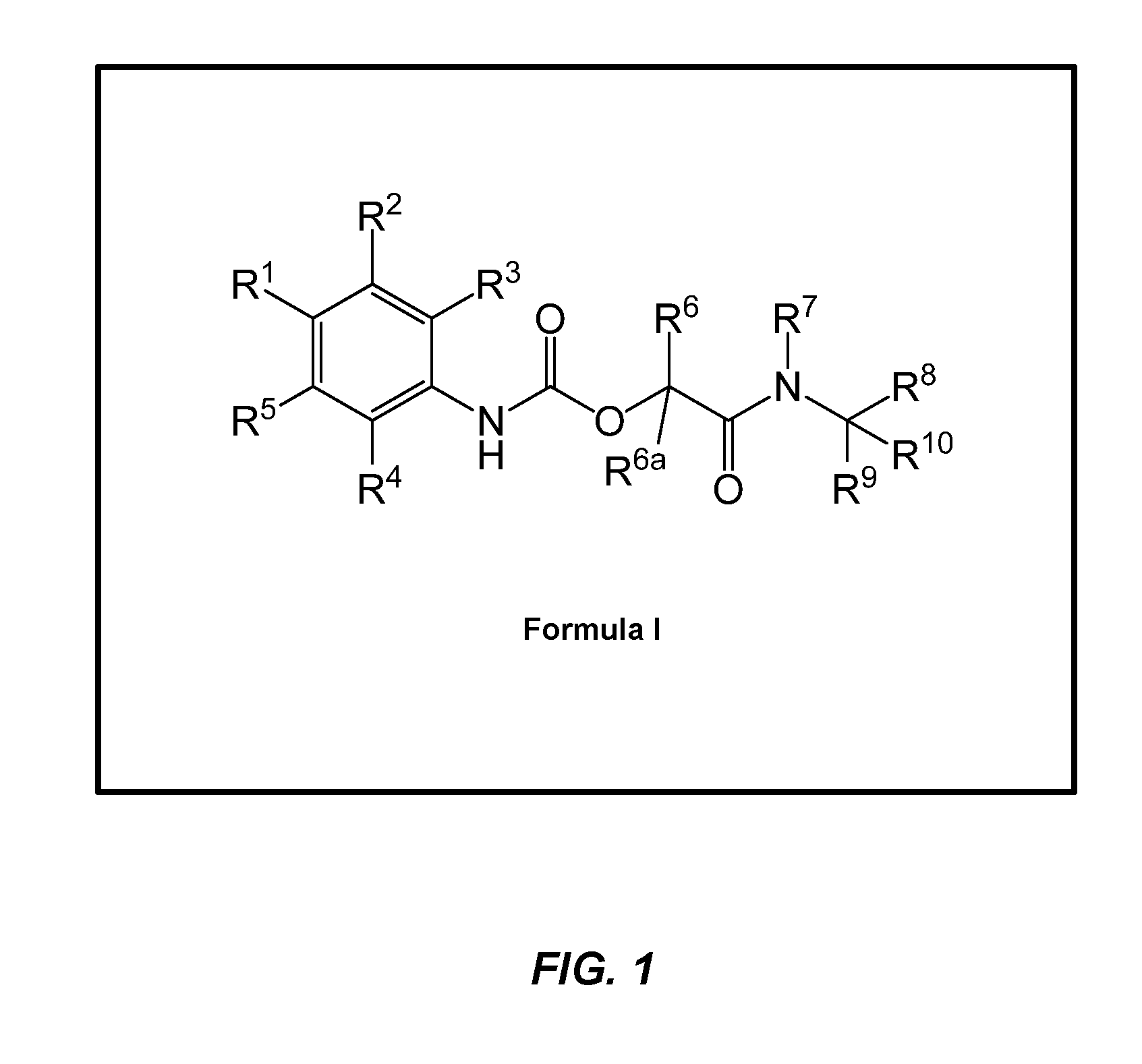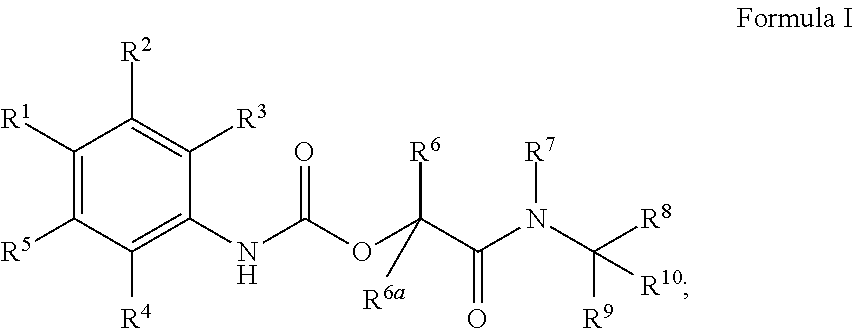Phenylcarbamate derivatives as formyl peptide receptor modulators
a technology of phenylcarbamate and formyl peptide receptor, which is applied in the direction of phosphorous compound active ingredients, drug compositions, group 5/15 element organic compounds, etc., can solve the problems of hampered drug utility of lipoxin a4 and its analogs
- Summary
- Abstract
- Description
- Claims
- Application Information
AI Technical Summary
Benefits of technology
Problems solved by technology
Method used
Image
Examples
example 1
Intermediate 1
(S)-tert-Butyl 2-(((4-Bromophenyl)carbamoyl)oxy)-4-methylpentanoate
[0295]
[0296]To a solution of (2S)-2-hydroxy-4-methyl-pentanoic acid, 1,1-dimethyl ethyl ester (1.10 g, 5.85 mmol) and 25 mL of methylene chloride at 25° C. was added 4-bromo-phenyl isocyanate (1.15 g, 5.85 mmol) and triethylamine (1.22 mL, 8.78 mmol). The resulting mixture was stirred at 25° C. for 4 hours. The mixture was concentrated and the residue was purified by medium pressure liquid chromatography on silica gel using ethyl acetate:hexane (8:92) to yield Intermediate 1 as viscous oil.
[0297]1H NMR (CD3OD, 300 MHz) δ: 7.33-7.47 (m, 4H), 4.87 (m, 1H), 1.56-1.91 (m, 1H), 1.47 (s, 9H), 0.93-1.04 (m, 6H).
Intermediate 2
tert-Butyl (2S)-4-Methyl-2-[({[4-(trifluoromethyl)phenyl]carbamoyl}oxy]pentanoate
[0298]
[0299]Intermediate 2 was prepared from the corresponding alpha-hydroxy carboxylic acid esterin a similar manner to the procedure described in Example 1 for Intermediate 1. Intermediate 2 was obtained as ...
example 2
Intermediate 3
(2S)-2-([(4-Bromophenyl)carbamoyl]oxy)-4-methylpentanoic acid
[0300]
[0301]A solution of Intermediate 1 (1.53 g, 3.98 mmol) and 20 mL of formic acid was stirred at 25° C. for 5 hours. The resulting mixture was quenched with water (20 mL) then extracted with ethyl acetate. The organic layer was washed with water, brine, dried over Na2SO4, filtered, and the filtrate was concentrated under reduced pressure. The residue was rinsed 4 times with methylene chloride:hexane (1:9) to yield Intermediate 3 as white solid; 1H NMR (CD3OD, 300 MHz) δ: 7.33-7.45 (m, 4H), 4.94-5.04 (m, 1H), 1.73-1.95 (m, 2H), 1.63-1.73 (m, 1H), 0.98 (dd, J=6.6, 3.7 Hz, 6H).
Intermediate 4
(2S)-4-Methyl-2-[({[4-(trifluoromethyl)phenyl]-carbamoyl}oxy]pentanoic acid
[0302]
[0303]Intermediate 4 was prepared from the corresponding carbamate derivative in a similar manner to the procedure described in Example 2 for Intermediate 3. Intermediate 4 was obtained as white solid; 1H NMR (CD3OD, 300 MHz) δ: 7.60-7.66 (m,...
example 3
Compound 1
tert-Butyl {[(2S)-2-{[(4-Bromophenyl)carbamoyl]oxy}-4-methyl pentanoyl]amino}acetate
[0304]
[0305]To a solution of Intermediate 3 (300 mg, 0.911 mmol) and 12 mL of anhydrous DMF at 25° C. was added EDCI (262 mg, 1.37 mmol), HOBt (185 mg, 1.37 mmol), glycine tert-butyl ester (179 mg, 1.37 mmol), and N-methylmorpholine (184 mg, 1.82 mmol). The resulting mixture was stirred at 25° C. for 12 hours. The mixture was quenched with water (5 mL), and the product was extracted with ethyl acetate (40 mL). The layers were separated, and the organic layer was washed with water, brine, dried over Na2SO4, filtered, and the filtrate was concentrated under reduced pressure. The resulting product was purified by medium pressure liquid chromatography on silica gel using ethyl acetate:hexane (1:4) to yield Compound 1 as white solid; 1H NMR (CD3OD, 300 MHz) δ: 7.34-7.46 (m, 4H), 5.10 (dd, J=9.5, 4.0 Hz, 1H), 3.75-3.94 (m, 2H), 1.73-1.92 (m, 2H), 1.60-1.72 (m, 1H), 1.45 (s, 9H), 0.99 (s, 3H), 0.9...
PUM
| Property | Measurement | Unit |
|---|---|---|
| Electrical conductance | aaaaa | aaaaa |
| Pharmaceutically acceptable | aaaaa | aaaaa |
Abstract
Description
Claims
Application Information
 Login to View More
Login to View More - R&D
- Intellectual Property
- Life Sciences
- Materials
- Tech Scout
- Unparalleled Data Quality
- Higher Quality Content
- 60% Fewer Hallucinations
Browse by: Latest US Patents, China's latest patents, Technical Efficacy Thesaurus, Application Domain, Technology Topic, Popular Technical Reports.
© 2025 PatSnap. All rights reserved.Legal|Privacy policy|Modern Slavery Act Transparency Statement|Sitemap|About US| Contact US: help@patsnap.com



